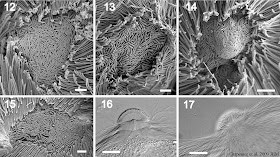(Carpenter, Chow and Keeling 2009. Morphology, Phylogeny, and Diversity of Trichonympha (Parabasalia: Hypermastigida) of the Wood-Feeding Cockroach Cryptocercus punctulatus. J Euk Microbiol 56:305-313
I stole these while the manuscript was in advance online publication, before the images were shrunk and butchered to fit print quality:




The little rod shaped things in 12-15 are some bacteria on the posterior end of the cell. 26-28 - after removing the anterior 'cap' (operculum). Scale bar is 10um in #2, for size comparison.
Trichonympha is this giant and utterly adorable wood-eating gut endosymbiont of early-branching dictyoptera (cockroaches and termites). Sadly, it's anaerobic and thereby difficult to play with unless you have a steady supply of termites going on in your lab, like those guys do. As for the wood roach from which these particular critters come from, it has to be ordered. This roach also has the amazing Saccinobaculus...Trichonympha can also be found in basal termites; we're lucky to have some native ones here in Vancouver (alas, devoid of Saccinobaculus =( )
It seems like cockroaches and termites formed endosymbiotic relationships with the protists before the two diverged - both groups have endosymbionts in their basal lineages, and lose them later on. The protistan endosymbiont diversity is wonderful: you have the aforementioned and much beloved 'snake-in-a-bag' (Saccinobaculus; can you tell I'm obsessed yet?) and fellow oxymonad companions like Streblomastix - a long cell with 'docking' for even longer episymbiont bacteria on it; Trichomitopsis and its protruding axostyle when it curls up into a ball; accompanied by loads of symbiont and parasitic bacteria.
The wood-eating dictyoptera require endosymbionts to digest cellulose, since we metazoans suck at it. The more derived termites can get by with bacteria it seems; but interestingly the protists are actually doing the digesting themselves in the basal termites - killing off the gut bacteria does not prevent the termite from being able to digest the wood, if I recall correctly from class... (was a while ago since we sliced up some termites and cockroaches). Either way, you end up with this complex society with protists of all sorts with bacterial endo- and episymbionts, as well as free-living forms. I find it amazing how this system survived locked inside the termite/roach guts for millions of years; it would not survive without them!
Most of the protists are anaerobic and lack conventional mitochondria, instead carrying highly reduced relics as mitosomes or hydrogenosomes; the latter produce hydrogen gas as a byproduct of their metabolic pathways. It was once thought those organisms were primarily amitochondriate, thus shoving them to the base of the eukaryotic tree, also known as the
Archezoan Hypothesis, put forth by Tom Cavalier-Smith; later this hypothesis was rejected as relics of ancient mitochondrial gene transfers were found in some of the host nuclei and the evidence accumulating for one of the prime archaezoans, microsporidia, being found to branch smack in the middle of fungi (beginnings of demise of Archaezoa discussed in Keeling 1998 BioEssays; free access).
It's 4am and I should stop procrastinating with my assignment... but here ya go. Aren't protists so cute and awesome? ^.^
CARPENTER, K., CHOW, L., & KEELING, P. (2009). Morphology, Phylogeny, and Diversity of Trichonympha(Parabasalia: Hypermastigida) of the Wood-Feeding Cockroach Cryptocercus punctulatus
Journal of Eukaryotic Microbiology, 56 (4), 305-313 DOI: 10.1111/j.1550-7408.2009.00406.x

wonderful, thanks for putting this up
ReplyDelete